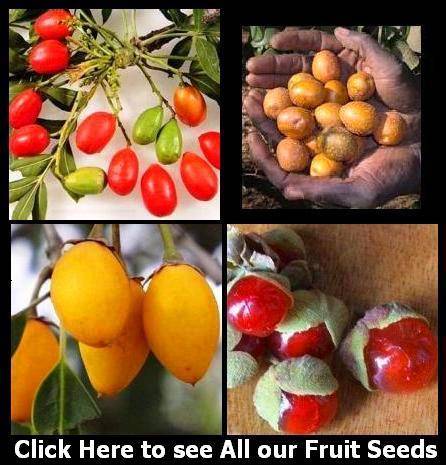
 Vangueria infausta Seeds
Vangueria infausta Seeds
Wild Medlar in English and Wilde Mispel

This species is one of South Africa's more popular veld fruits, and can be enjoyed while walking. This lovely little tree is considered to possess evil powers and not even the wood should be used for making fire. It is believed that it could cause cattle to bear only male offspring. Despite this, the plant is used extensively.
 Vangueria infausta commonly known as Wild Medlar in English and Wilde Mispel in Afrikaans is a deciduous shrub or small tree that varies in height from 3-7 m, depending on the habitat. It can be single or multistemmed, but usually the latter. The bark is greyish to yellowish brown, smooth and peeling in irregular small strips. The branchlets are covered with short, woolly hairs, especially when young. Soft, velvety, acorn-shaped buds appear either before or simultaneously with the new leaves around September to October. These open into small flowers, greenish white to yellowish in colour. They occur in clusters along the short lateral branches. The fruit is almost round, glossy dark green when young and changing to a light brown when ripe. The ripe fruit is soft and fleshy with a leathery shin that encloses 3-5 seeds embedded in soft pulp. The fruit is edible and has a pleasant sweet-sour, mealy taste. It tastes like an apple. It can be found on the plants from January to April. The remains of the old flower base can be seen on the tip of the fruit.
Vangueria infausta commonly known as Wild Medlar in English and Wilde Mispel in Afrikaans is a deciduous shrub or small tree that varies in height from 3-7 m, depending on the habitat. It can be single or multistemmed, but usually the latter. The bark is greyish to yellowish brown, smooth and peeling in irregular small strips. The branchlets are covered with short, woolly hairs, especially when young. Soft, velvety, acorn-shaped buds appear either before or simultaneously with the new leaves around September to October. These open into small flowers, greenish white to yellowish in colour. They occur in clusters along the short lateral branches. The fruit is almost round, glossy dark green when young and changing to a light brown when ripe. The ripe fruit is soft and fleshy with a leathery shin that encloses 3-5 seeds embedded in soft pulp. The fruit is edible and has a pleasant sweet-sour, mealy taste. It tastes like an apple. It can be found on the plants from January to April. The remains of the old flower base can be seen on the tip of the fruit.
The fruit is mostly eaten raw but in some parts it is stored as dried fruit to be used in time of food scarcity. It is said that mampoer, a strong alcoholic drink or brandy can be distilled from it or fermented to make beer. If mixed with a little water and sugar it produces an acceptable substitute for apple sauce. The fruit juice can also be used for flavouring purposes by squeezing it out in water, discarding the seed and skins. This is done often for flavouring porridge. According to Betsie Rood (1994) vinegar can be produced from the fruit. This plant has medicinal value as well. An infusion of the roots and leaves has been used to treat malaria, chest ailments like pneumonia, as a purgative and to treat ringworms. An infusion of the leaves is used for the relief of toothache. For the treatment of swelling of the limbs the affected parts are bathed in a decoction of the pounded leaves and small twigs, especially in children.
On offer is a pack of 10 Seeds
We'll supply you with all the germination & care instructions.




